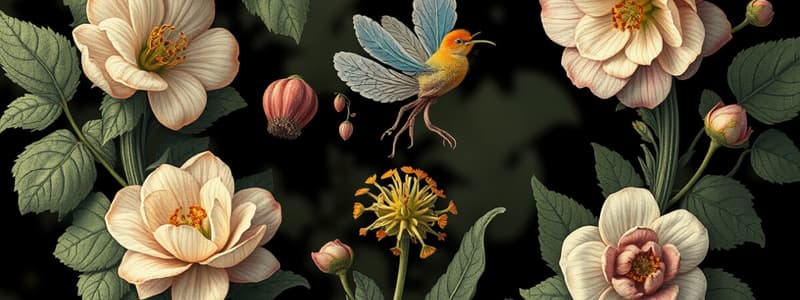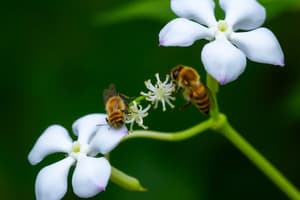Podcast
Questions and Answers
Which part of the flower is primarily responsible for male reproduction?
Which part of the flower is primarily responsible for male reproduction?
- Petal
- Sepal
- Pistil
- Stamen (correct)
What is the process called when pollen is transferred from the anther to the stigma?
What is the process called when pollen is transferred from the anther to the stigma?
- Seed Dispersal
- Pollination (correct)
- Germination
- Fertilization
Which type of pollination occurs when pollen from the same flower fertilizes its ovules?
Which type of pollination occurs when pollen from the same flower fertilizes its ovules?
- Wind Pollination
- Animal Pollination
- Cross-Pollination
- Self-Pollination (correct)
During fertilization in flowering plants, what develops as a result of the fusion of male and female gametes?
During fertilization in flowering plants, what develops as a result of the fusion of male and female gametes?
What type of fruit develops from multiple ovaries of a single flower?
What type of fruit develops from multiple ovaries of a single flower?
Which mechanism of seed dispersal involves seeds being carried by wind?
Which mechanism of seed dispersal involves seeds being carried by wind?
What is required for seed germination to occur?
What is required for seed germination to occur?
What transforms into a seed after fertilization in flowering plants?
What transforms into a seed after fertilization in flowering plants?
Flashcards are hidden until you start studying
Study Notes
Chapter 2: Sexual Reproduction in Flowering Plants
Key Concepts:
-
Modes of Reproduction:
- Sexual reproduction involves the fusion of male and female gametes.
- Flowering plants (angiosperms) exhibit sexual reproduction through flowers.
-
Flower Structure:
- Stamen: Male reproductive part consisting of anther and filament.
- Pistil (Carpel): Female reproductive part made up of stigma, style, and ovary.
- Petals and Sepals: Attract pollinators and protect reproductive parts.
-
Pollination:
- Transfer of pollen from anther to stigma.
- Types:
- Self-Pollination: Pollen from the same flower or plant.
- Cross-Pollination: Pollen from different plants, often facilitated by wind, insects, or water.
-
Fertilization Process:
- Occurs after pollination when pollen grain germinates on stigma.
- Pollen tube grows down the style to reach the ovule in the ovary.
- Fusion of male gamete (from pollen) with female gamete (from ovule) forms zygote.
-
Development of Seed and Fruit:
- After fertilization, zygote develops into an embryo.
- Ovule transforms into a seed; ovary develops into a fruit.
- Seeds contain the embryo and are essential for plant propagation.
-
Types of Fruits:
- Simple Fruits: Develop from a single ovary (e.g., cherries).
- Aggregate Fruits: Formed from multiple ovaries of a single flower (e.g., strawberries).
- Multiple Fruits: Derived from a cluster of flowers (e.g., pineapples).
-
Seed Dispersal:
- Mechanisms for spreading seeds to new locations:
- Wind Dispersal: Lightweight seeds (e.g., dandelions).
- Water Dispersal: Seeds that float (e.g., coconuts).
- Animal Dispersal: Seeds attached to fur or consumed and excreted.
- Mechanisms for spreading seeds to new locations:
-
Germination:
- The process by which a seed develops into a new plant.
- Requires suitable conditions (water, temperature, oxygen).
Important Terms:
- Gametes: Reproductive cells (sperm and egg).
- Zygote: Fertilized egg.
- Embryo: Early developmental stage of the seed.
- Pollinators: Agents (insects, birds) that aid in pollination.
Summary:
Sexual reproduction in flowering plants is a complex process involving flower structure, pollination, fertilization, seed and fruit development, and seed dispersal, leading to the continuation of plant species through germination. Understanding these processes is essential for insights into plant biology and ecology.
Modes of Reproduction
- Sexual reproduction in flowering plants (angiosperms) involves male and female gamete fusion.
Flower Structure
- Stamen: The male reproductive organ comprised of the anther, which produces pollen, and the filament.
- Pistil (Carpel): The female reproductive organ, including the stigma (receives pollen), style (connects stigma to ovary), and ovary (contains ovules).
- Petals and Sepals: Petals attract pollinators, while sepals protect the reproductive structures.
Pollination
- The process of pollen transfer from anther to stigma; vital for fertilization.
- Self-Pollination: Occurs within the same flower or plant, ensuring fertilization without external agents.
- Cross-Pollination: Involves pollen from different plants, often aided by external factors like wind or insects.
Fertilization Process
- Begins after successful pollination when the pollen grain germinates on the stigma.
- A pollen tube grows through the style to the ovary, allowing the male gamete to fuse with the female gamete in the ovule, resulting in the formation of a zygote.
Development of Seed and Fruit
- Post-fertilization, the zygote develops into an embryo.
- The ovule transforms into a seed, while the ovary evolves into a fruit, crucial for protecting seeds and aiding in dispersal.
Types of Fruits
- Simple Fruits: Develop from a single ovary (e.g., cherries).
- Aggregate Fruits: Formed from multiple ovaries of a single flower (e.g., strawberries).
- Multiple Fruits: Result from a cluster of flowers (e.g., pineapples).
Seed Dispersal
- Mechanisms that help spread seeds to new areas:
- Wind Dispersal: Lightweight seeds, such as dandelions, are carried by the wind.
- Water Dispersal: Seeds that can float, like coconuts, travel via water bodies.
- Animal Dispersal: Seeds hitch a ride on animal fur or are consumed and dispersed through excretion.
Germination
- The process where a seed develops into a new plant, requiring optimal conditions, including adequate water, appropriate temperature, and oxygen availability.
Important Terms
- Gametes: Sperm and egg cells responsible for reproduction.
- Zygote: The fertilized egg resulting from the fusion of gametes.
- Embryo: The initial developmental stage of the seed.
- Pollinators: Organisms (like insects and birds) that facilitate the transfer of pollen between flowers.
Summary
- Understanding sexual reproduction in flowering plants encompasses flower structure, pollination, fertilization, seed and fruit development, and dispersal methods, crucial for the survival and propagation of plant species.
Studying That Suits You
Use AI to generate personalized quizzes and flashcards to suit your learning preferences.




